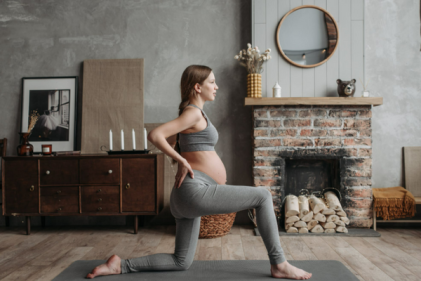 Current evidence suggests that as long as your pregnancy and delivery were uncomplicated, mild exercise such as walking, pelvic floor exercises and gentle stretching can begin almost immediately. Aerobic exercise, like swimming, low impact aerobics or cycling, which is vital for regaining general fitness and losing excess body fat, can begin six weeks after a normal delivery.
Current evidence suggests that as long as your pregnancy and delivery were uncomplicated, mild exercise such as walking, pelvic floor exercises and gentle stretching can begin almost immediately. Aerobic exercise, like swimming, low impact aerobics or cycling, which is vital for regaining general fitness and losing excess body fat, can begin six weeks after a normal delivery.
For those mums who had a Caesarean section, you will need more guidance in the first few weeks on what exercise you can safely do. The Chartered Physiotherapist in the hospital can advise you. Regarding returning to aerobic exercise, you will also need advice on when you are safe to start back – make sure to discuss it with your GP or Obstetrician during your post-natal check-up.
The main thing to bear in mind is that you should not push yourself if you are not feeling up to it. Many woman feel great pressure to bounce back to their pre-pregnancy weight and often overdo it, especially if they are very tired from sleepless nights.
If you notice any of the following symptoms when you start to exercise again, please stop immediately and contact your GP:
-
Increased bleeding (not your period)
-
Abdominal pain
-
Mastitis
-
Fainting, dizzy spells or severe headaches

Look after yourself when building back up to your pre-pregnancy fitness, and remember these tips:
-
Stop if you feel specific pain in a specific body part – general muscular aching for one to two days post exercise is normal, localised sharp pain is not.
-
Stop if you feel very tired.
-
Do a little and often, to gradually build up your fitness.
-
Wear proper footwear when out walking (no flip-flops or flat, trendy trainers).
-
Maintain good posture when pushing the buggy (check that the handle of your buggy is the right height for you).
-
Do not even think about running until you are fit to walk at a fast pace for at least 30-45 minutes.
-
Attend your Chartered Physiotherapist for a rehab programme if you have abdominal separation (also known as gapping or Diastasis Recti). Make sure you attend someone who specialises in this area of women’s health.
-
Avoid sit-ups, crunches and double leg lifts – if you have any abdominal gapping, these exercises will make it worse. They also put too much pressure on your lower back.
-
Focus on your balance to improve the control of your knee and ankle joints as your ligaments tighten back up again. Standing on one foot and holding for up to 30 seconds is a great start, and you can make it harder by closing your eyes or standing on a more uneven surface. Repeat this regularly throughout the day.
-
If you “leak” when exercising (or when coughing or laughing), beware. If this continues after approximately six weeks, you will need to contact a Chartered Physiotherapist who specialises in this specific area, for an assessment and treatment plan.

Please note:
If you have pain or any concerns while pregnant or in the postnatal period, please report them to your Chartered Physiotherapist, GP or obstetrician ASAP. Do not suffer in silence. If in doubt, get it checked out. Not all aches and pains are normal and it is important to resolve any issues that are affecting your ability to go about your daily business.



